The Sun Salutation is well-known to most yoga practitioners, but what about the Moon Salutation, which is less well-known? The Moon Salutation, also called Chandra Namaskar in Sanskrit, is a cooling and calming technique for the body and mind.
- When to Practice Chandra Namaskar
- Moon Salutation vs. Sun Salutation
- How to Perform the Chandra Namaskar Sequence for the Moon Salutation
- Step1 Pranamasana (Prayer Pose)
- Step2 Hasta Utthanasana (Raised Arms Pose)
- Step3. Padahastasana (Hand to Foot Pose)
- Step4. Ashwa Sanchalanasana (Equestrian Pose)
- Step5. Ardha Chandrasana (Half Moon Pose)
- Step6. Parvatasana (Mountain Pose)
- Step7. Ashtanga Namaskar (Salute with Eight Parts)
- Step8. Bhujangasana (Cobra Pose)
- Step9. Parvatasana (Mountain Pose)
- Step10. Ashwa Sanchalanasana (Equestrian Pose)
- Step11. Ardha Chandrasana (Half Moon Pose)
- Step12. Padahastasana (Hand to Foot Pose)
- Step13. Hasta Utthanasana (Raised Arms Pose)
- Step14. Pranamasana (Prayer Pose)
- And Now… the Other Side!
- Benefits of Chandra Namaskar
- Closing Thoughts
- Chandra Namaskar for Evening Practice
- Conclusion
- FAQ
This sequence, which is also called the Lunar Salutation and translates to “salutations to Lord Moon,” has its roots in ancient India, when the moon was considered a god. “Bright, shining, or glittering” is the precise definition of the word “chandra.”Chandra Namaskar
Ten white horses or an antelope were said to pull Lord Chandra, the moon’s god, as he rode his chariot across the sky each night. He was also connected to fertility, vegetation, and the night.
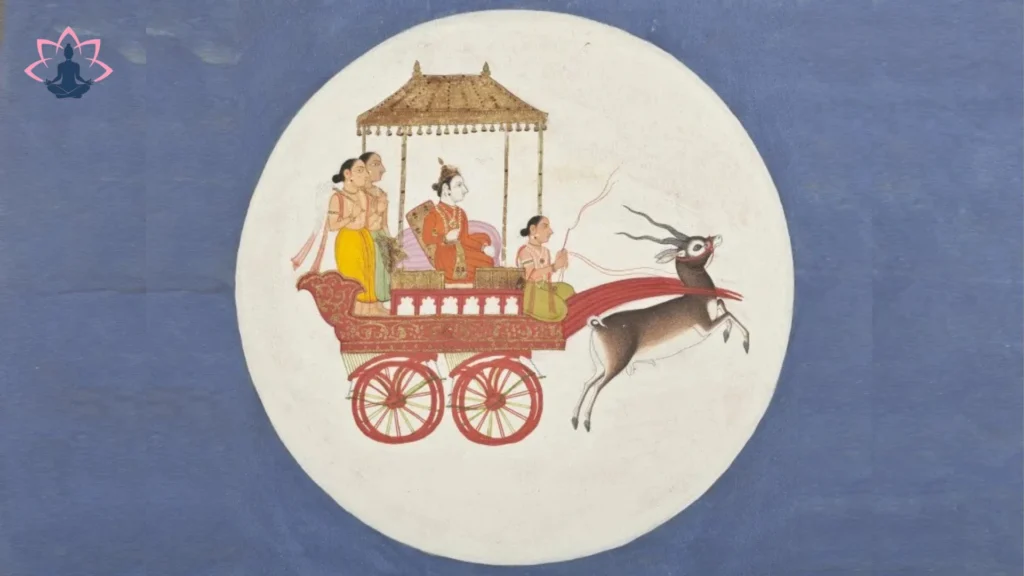
The moon is a symbol of the brain and intellect, emotions, sensitivity, gentleness, and imagination in Vedic astrology. It represents the universe’s feminine creative energy. Many individuals still assume that the moon has a big impact on our thoughts and emotions.
You can do Chandra Namaskar to respect the moon’s might. The fourteen poses in the sequence correspond to the fourteen phases of the moon. It incorporates mindfulness methods, pranayama, and mantra with the postural practice.
Moon Salutations are therefore good for your mind and spirit in addition to your physical body. They facilitate your expansion and release, two of the full moon’s primary cosmic themes. Now let’s explore this mysterious sequence!
When to Practice Chandra Namaskar
The greatest time to do the Moon Salutation is at night or in the evening, particularly when the moon is visible. Chandra Namaskar should only be done on an empty stomach, just like any other yoga pose. Unless you have a small lunch, you should wait at least three hours after your previous meal if you are training at night.
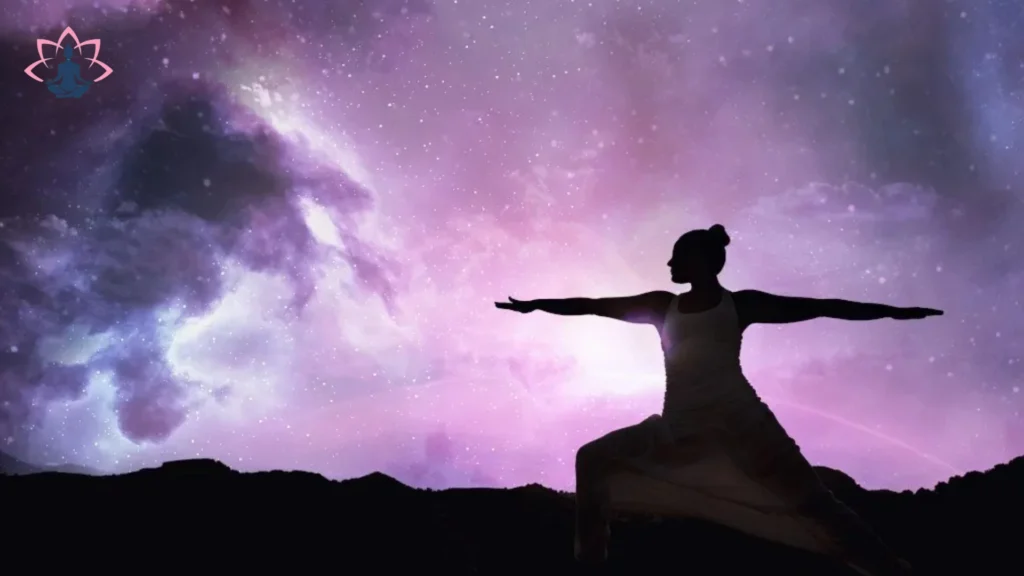
When the moon is full at sunrise, you can also do the Lunar Salutation. Other lineages do not include the Ashtanga Vinyasa tradition’s recommendation that practitioners refrain from yoga during the full moon.
Conversely, doing yoga during a full moon may assist practitioners in letting go of things that no longer serve them and sowing seeds of purpose for the next moon. You might choose a leisurely Chandra Namaskar or any mild sequence to respect the cycles of nature.
Moon Salutation vs. Sun Salutation
With one more position, the Moon Salutation follows the same pattern as the Sun Salutation. Ardha Chandrasana, also known as Half Moon, is an additional posture that promotes balance and focus. Additionally, it lengthens the inhale and exhale, altering the breathing rhythm in the series. It is advised that you master the Sun Salutation first if you are unfamiliar with it.
See also: Surya Namaskar: Your Step-by-Step Guide to Perfect Sun Salutations
Surya Namaskar heats and activates the solar energy inside, whereas Chandra Namaskar cools and activates the lunar energy. You may be asking how the sequences may have such opposite impacts when they are so similar.
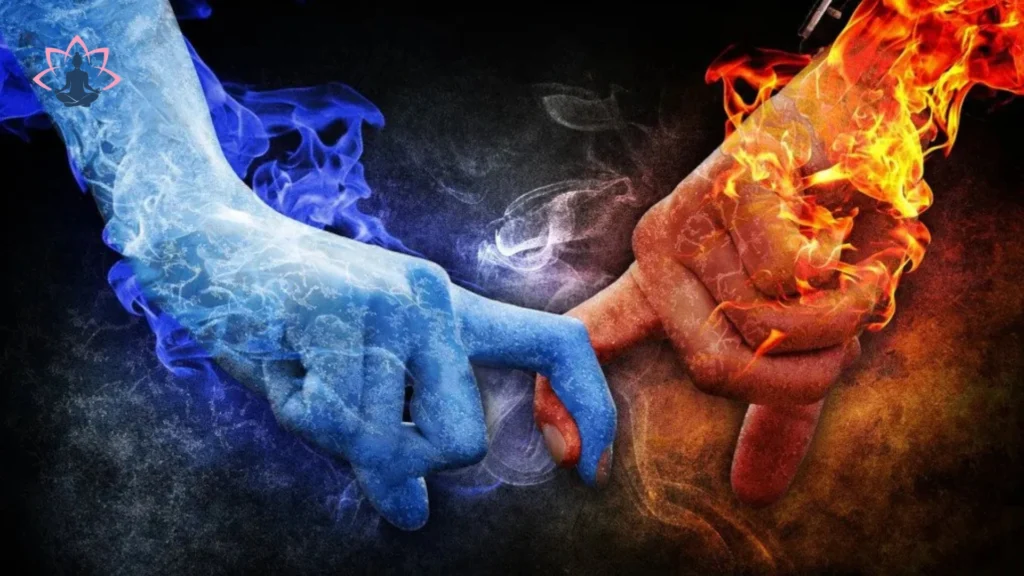
It may surprise you to hear that a sequence’s odd effects aren’t always caused by the motions themselves. Rather, it is the purpose behind your exercise. The following advice may help you alter your mood and energy levels while doing the Lunar Salutation:
- Take your time and move gently.
- Don’t be too strong or intense.
- Pay attention to the little motions.
Let the lunar traits of peace, submission, and introspection be evoked by the practice.
You may also incorporate a brief visualization at the start of your practice to aid with this process. Pay attention to the area between your eyebrows. Imagine the full moon shining in a bright night sky inside this area. It gleams brilliantly on the sea. Watch the waves dance in the chilly moonlight’s reflection. Take note of the emotions and sensations this picture evokes in your body.
Begin your Moon Salutation practice as soon as you feel at ease and in control.
How to Perform the Chandra Namaskar Sequence for the Moon Salutation
The Chandra Namaskar sequence encompasses a wide variety of sequences. Therefore, discussing Moon Salutations is more appropriate. The stages of the traditional Moon Salutation, breathing technique, mantras to recite, and chakras to concentrate on are all included in this article.
A thorough, step-by-step tutorial to doing the Moon Salutation may be found below. To unwind and calm your body and mind, we suggest doing Kat’s Moon Salutation Flow on Online Studio if you’re ready for an energizing Hatha Vinyasa session.
Step1 Pranamasana (Prayer Pose)
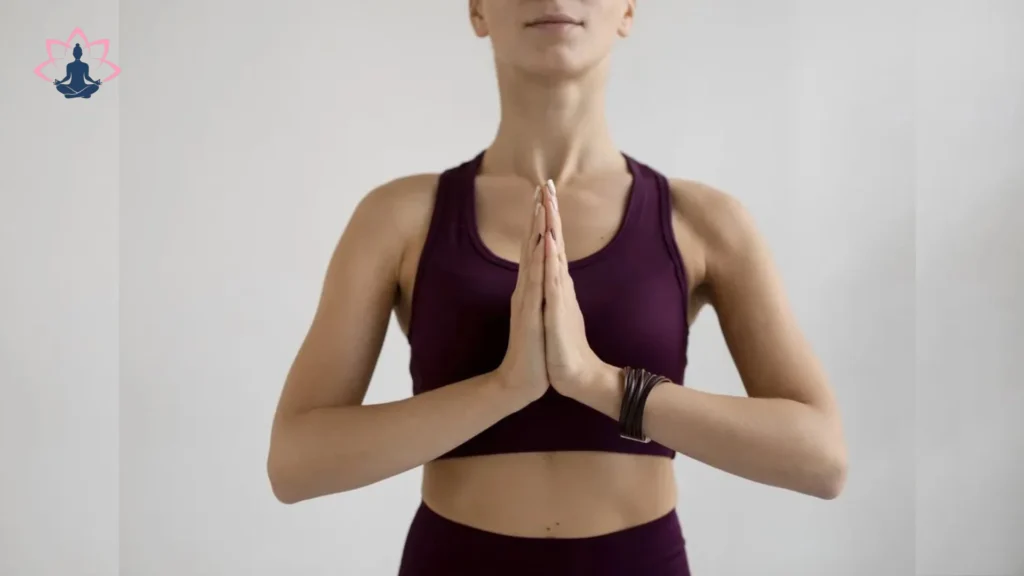
1. Start by standing with your heels slightly apart, big toes touching, and feet firmly planted in the ground.
2. Roll your shoulders back, stretch your spine, and gently lean your tailbone downward.
3. To develop humility and awareness of the heart center, bring your hands together in front of your chest and look down to your fingers.
- Breath: Normal
- Chakra: Anahata (Heart) Chakra
- Mantra: Om Kameshvaryai Namaha
- Meaning: Salutations to one who fulfills desires
Step2 Hasta Utthanasana (Raised Arms Pose)
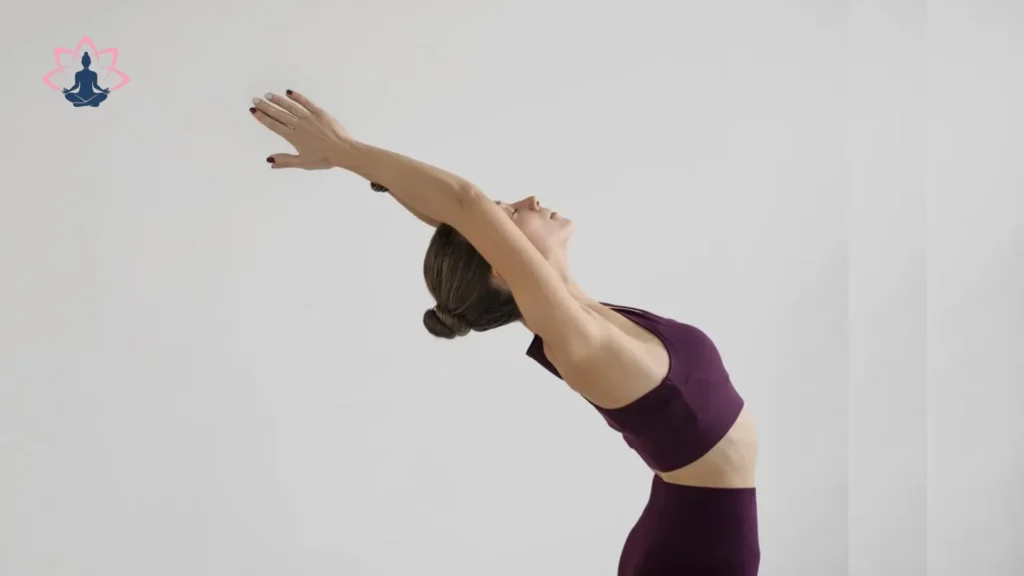
1. Inhale and lift your arms overhead.
2. Your gaze follows your fingers.
3. Keep your heels down to the floor, tilt your pelvis forward, and gently arch your back.
4. You should only bend back as much as it feels comfortable. Pay close attention to your lower back.
5. Pay attention to the opening in your upper torso, where your belly stretches and your lungs expand.
- Breath: Inhale
- Chakra: Vishuddhi (Throat) Chakra
- Mantra: Om Bhagamalinyai Namaha
- Meaning: Best wishes to the wearer of the prosperity garland
Step3. Padahastasana (Hand to Foot Pose)
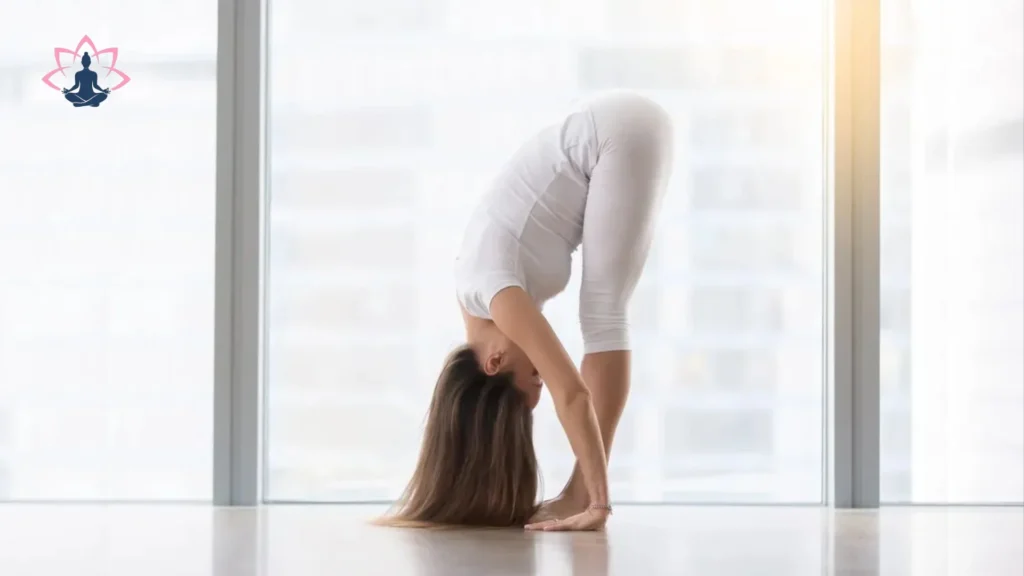
1. Breathe out, stoop forward, and plunge through the midline.
2. Place your shins or your hands or fingers on the ground.
3. Stress the extension of your spine when you are in the forward bend.
4. To extend your spine and loosen your hamstrings, bend your knees a little if your back rounds.
5. Pay attention to the feelings in your pelvis and back.
- Breath: Exhalation
- Chakra: Svadhisthana (Sacral) Chakra
- Mantra: Om Nityaklinnayai Namaha
- Meaning: Greetings to a person who is always kind
Step4. Ashwa Sanchalanasana (Equestrian Pose)
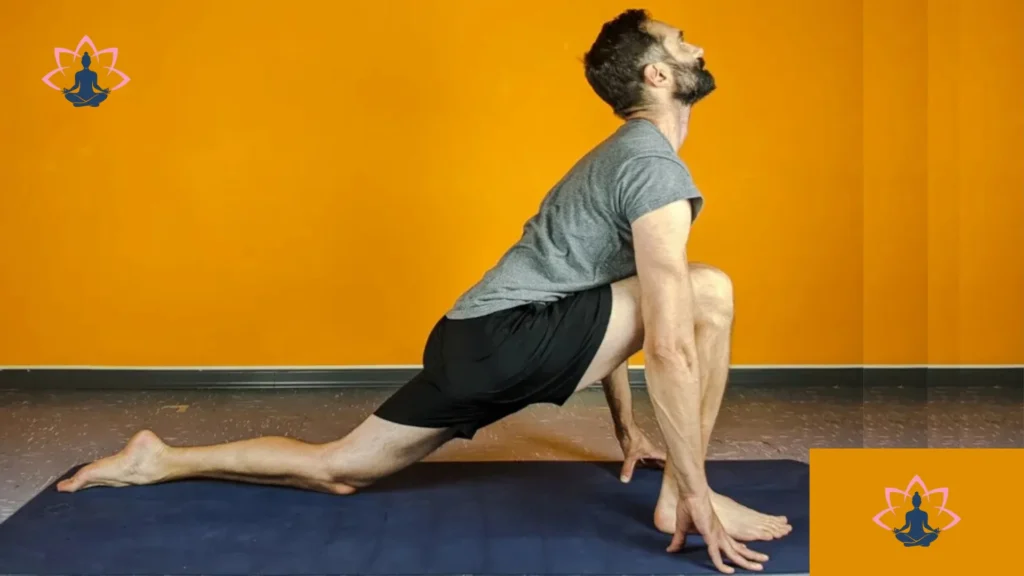
1. Inhale slowly, then take a step back with your left foot, bringing your knee down to the floor.
2. Maintaining the same foot posture, simultaneously bend your right knee.
3. Frame your front foot with your hands.
4. Look up toward the middle of your eyebrows while arching your back.
- Breath: Inhalation
- Chakra: Ajna (Third-Eye) Chakra
- Mantra: Om Bherundayai Namaha
- Meaning: Salutations to one who is ferocious
Step5. Ardha Chandrasana (Half Moon Pose)
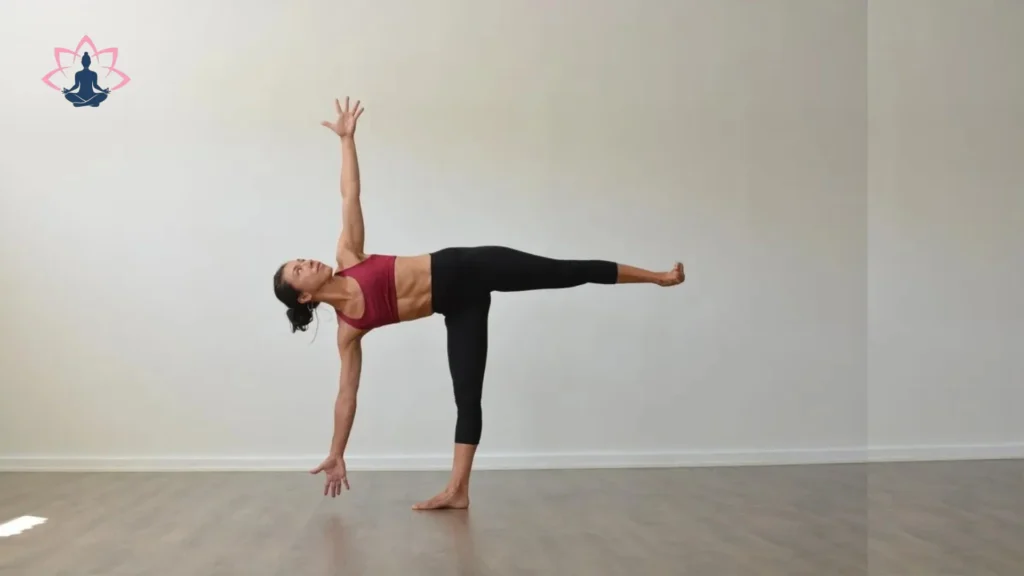
1. Holding both arms shoulder-width apart, raise them above your head and continue inhaling.
2. Raise your chin toward the ceiling, arch your back, and look up.
3. Your body will gently bend from the tips of your fingers to the tips of your left toes, mimicking the crescent 4. moon, if you have a lot of flexibility.
5. Keep the breath within and hold this form for a time.
6. Then, as you drop your arms to the floor, framing your front foot, softly start to exhale.
- Breath: Inhalation / Exhalation
- Chakra: Vishuddhi (Throat) Chakra
- Mantra: Om Vahnivasinyai Namaha
- Meaning: Greetings to a resident of a fire
Step6. Parvatasana (Mountain Pose)
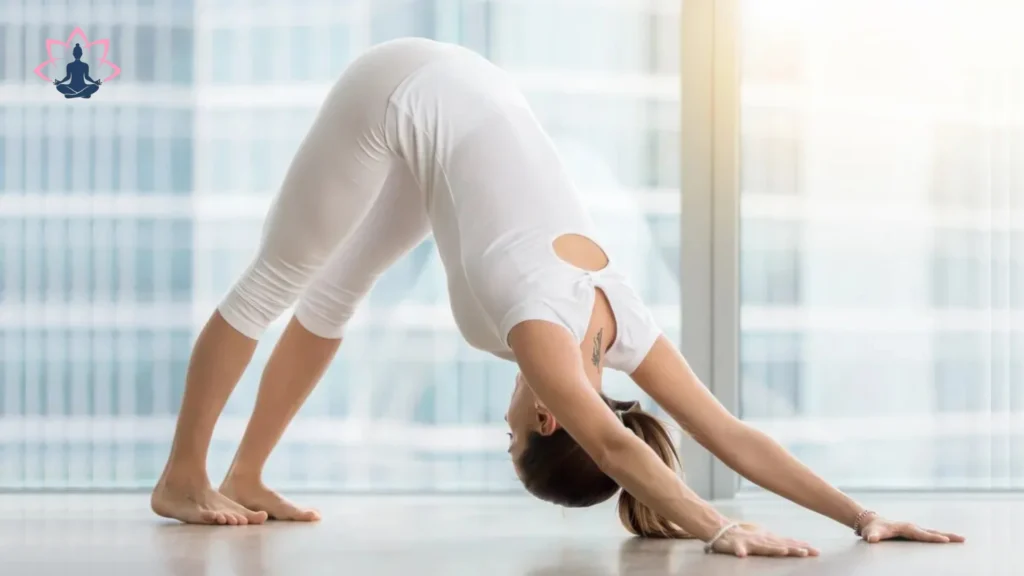
1. Stepping the left foot back next to the right, continue to exhale.
2. Lower your head between your arms and raise your tailbone to the heavens simultaneously.
3. Keep both knees bent if your back starts to tense.
4. Once more, you may stretch your spine by doing this.
5. You might eventually be able to pull your heels down to the floor and straighten your legs.
6. Concentrate on your throat center.
7. Hold your breath at the end of the exhale before going on to the next posture.
- Breath: Exhalation
- Chakra: Vidhuddhi (Throat) Chakra
- Mantra: Om Vajreshvaryai Namaha
- Meaning: Salutations to the person wearing diamond jewels and wielding the thunderbolt, vajra.
Step7. Ashtanga Namaskar (Salute with Eight Parts)
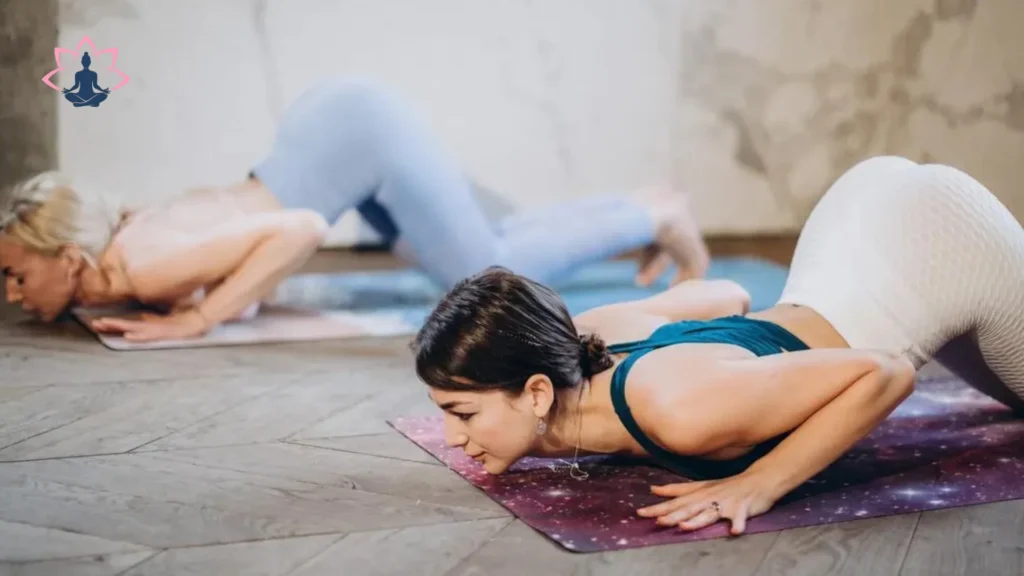
1. At the conclusion of the exhale, hold your breath.
2. First, drop your knees to the floor.
3. Then, with your elbows close to your body, drop your chest between your hands.
4. Finally, touch your chin to the ground.
5. Continue gazing forward.
6.Maintain a lifted belly and hips while keeping your toes tucked beneath.
7. Typically, this position is executed while holding your breath.
8. You can breathe properly if the breath retention puts stress on your lungs.
- Breath: External Retention
- Chakra: Manipura (Solar Plexus) Chakra
- Mantra: Om Dutyai Namaha
- Significance: Greetings to a person whose message is Shiva
Step8. Bhujangasana (Cobra Pose)
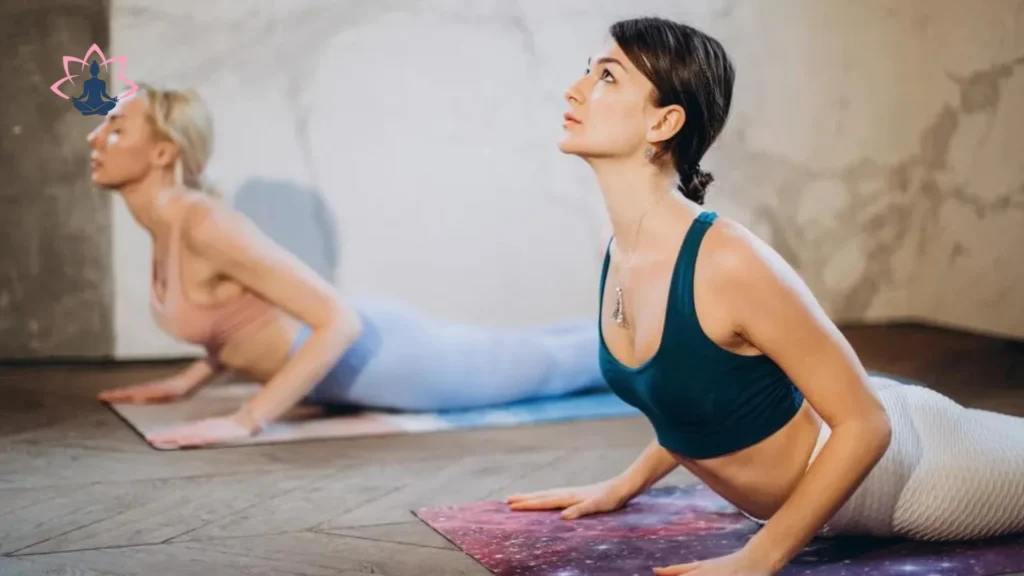
1. Inhale and slide your chest forward.
2. You can hug your elbows toward your body while maintaining a bend in them.
3. You can straighten the arms for a more difficult backbend.
4. Look up toward the middle of your eyebrows while bending your head back.
5. Firm your shoulder blades against your back and lower your shoulders away from your ears.
6. As you press your legs and the tops of your feet into the mat, keep raising through your chest.
- Breath: Inhalation
- Chakra: Svadhisthana (Sacral) Chakra
- Mantra: Om Tvaritayai Namaha
- Meaning: Salutations to one who is swift
Step9. Parvatasana (Mountain Pose)

The stances at the start of the series will now be repeated, but in the opposite order. The instructions will be shorter as a result. Pay attention to the same chakras as previously, but note that the mantras are always shifting.
1. Exhale and tuck your toes.
2. Alternatively, you can roll over the feet.
3. Return to Parvatasana by raising your hips.
4. Lengthen through your arms and shoulders and send your chest toward your thighs.
5. Press your knuckles into the carpet and spread your fingers wide to keep your hands anchored.
- Breath: Exhalation
- Chakra: Vishuddhi (Throat) Chakra
- Mantra: Om Kulasundaryai Namaha
- Meaning: Greetings to a good, honorable, and affable person
Step10. Ashwa Sanchalanasana (Equestrian Pose)

1. Breathe in deeply while bending your knee and placing your right foot between your palms.
2. Push your pelvis forward and drop your left leg to the floor at the same time.
3. Look up toward the middle of your eyebrows while arching your back.
- Breath: Inhalation
- Chakra: Ajna (Third-Eye) Chakra
- Mantra: Om Nityayai Namaha
- Meaning: Salutations to one who is eternal
Step11. Ardha Chandrasana (Half Moon Pose)

1. As you raise both arms above your head, continue inhaling.
2. Look up and arch your back to mimic the crescent moon’s form.
3. For a second, hold this stance while holding your breath.
4. Then, as you drop your arms to the floor, framing your front foot, softly start to exhale.
- Breath: Inhalation / Exhalation
- Chakra: Svadhisthana (Sacral) Chakra
- Mantra: Om Nilapatakinyai Namaha
- Meaning: Greetings to the person wearing a blue flag.
Step12. Padahastasana (Hand to Foot Pose)

1. Continue the exhalation.
2. To meet your left foot, step forward with your right foot.
3. Bring the forehead as near to the knees as you can without straining by folding forward.
4. Keep in mind that depending on your level of flexibility, you can bend or straighten your legs.
- Breath: Exhalation
- Chakra: Svadhisthana (Sacral) Chakra
- Mantra: Om Vijayayai Namaha
- Meaning: Best wishes to the winner of all battles
Step13. Hasta Utthanasana (Raised Arms Pose)

1. To ascend into Hasta Utthanasana, inhale.
2. As you dive higher, maintain a straight spine and use your core muscles.
3. Lift your arms over your head, stoop as far back as you can, and turn to face your hands.
- Breath: Inhalation
- Chakra: Vishuddhi (Throat) Chakra
- Mantra: Om Sarvamangalayai Namaha
- Meaning: Greetings to the person who bestows all good luck
Step14. Pranamasana (Prayer Pose)

1. After exhaling, put your hands together in Prayer Pose and drop your arms in front of your chest.
2. After that, let your arms drop to your sides, unwind, and concentrate on your breathing until it resumes its regular pattern.
- Breath: Exhalation
- Chakra: Anahata (Heart) Chakra
- Mantra: Om Jvalamalinyai Namaha
- Meaning: A greeting to someone who is surrounded by fire at all times.
And Now… the Other Side!
You must repeat the identical sequence on the opposite side to finish a full round. The fourth posture, Ashwa Sanchalanasana, requires you to step back with your right foot rather than your left. Step your left foot between your palms as you advance into Ashwa Sanchalanasana, the ninth posture.
Spend some time resting in Savasana at the conclusion of your practice. This last relaxation enables your muscles to rest, your heart and breathing to calm, and your body and mind to assimilate the practice’s results.
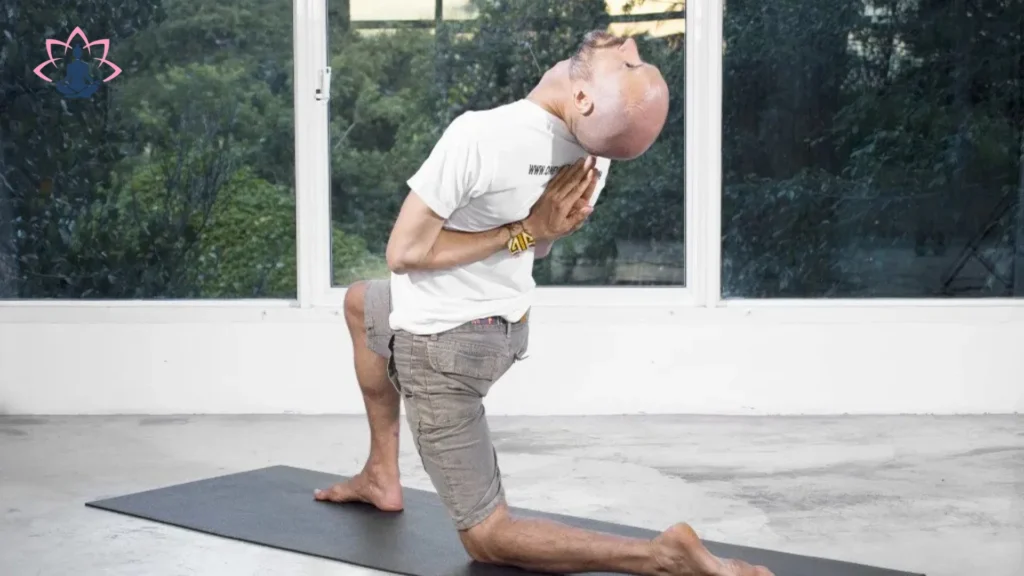
You may follow Jamie in Moon Salutation Yoga if you’d want to attempt another well-liked version of the Moon Salutation. The Bihar School of Yoga created this sequence in the 1960s. This little course is intended to help you regain equilibrium when you feel emotionally overburdened or even full.
Benefits of Chandra Namaskar
Chandra Namaskar is a wonderful exercise that has several advantages. In terms of the body, it relaxes rigid joints and muscles. Additionally, it massages and tones the internal organs, which may aid in detoxification and better digestion.
Additionally, the practice improves endurance, strength, flexibility, and mental-physical coordination. All bodily systems, including the respiratory, digestive, reproductive, endocrine, and circulatory systems, are balanced by it.
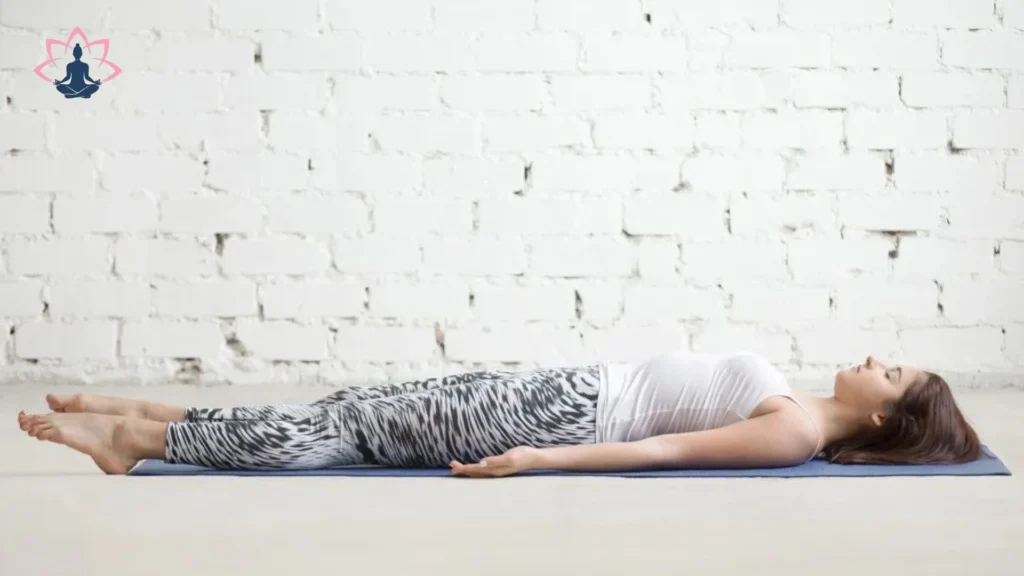
On a deeper level, Chandra Namaskar promotes inner equilibrium, creativity, and mental calmness. It controls the moon energy channel, ida nadi. Sun Salutations, on the other hand, control the sun energy channel, or pingala nadi.
Consciousness expands when life force energy (prana) enters the central energy channel and climbs higher when the sun and moon energies are in harmony. One of the primary objectives of Hatha Yoga is this. In actuality, a lot of people think that tha is the moon and ha is the sun.
Closing Thoughts
It’s important to keep in mind that Chandra Namaskar is more than simply a series of positions as we get to the end of this enlightening trip. It’s a call to engage with the moon’s ethereal forces, which impact our soul, intellect, and emotions.
The Moon Salutation embodies the feminine qualities of creativity, serenity, and introspection, providing a unique fusion of physical elegance and spiritual wisdom. You may develop physical flexibility as well as emotional equilibrium and spiritual harmony by doing it with mindfulness and intention.
Imagine yourself lining up with the lunar phases as you flow through each pose, recite the mantras, and concentrate on the chakras. Each phase symbolizes a different aspect of life’s complex path.
Chandra Namaskar provides a hallowed area for introspection, recharging, and harmonization, whether you practice in the seclusion of a fading crescent or the light of a full moon. In a world where the sun’s zeal frequently guides us, we must remember the moon’s peaceful wisdom. The moon is always there, illuminating the night with her kind and caring light.
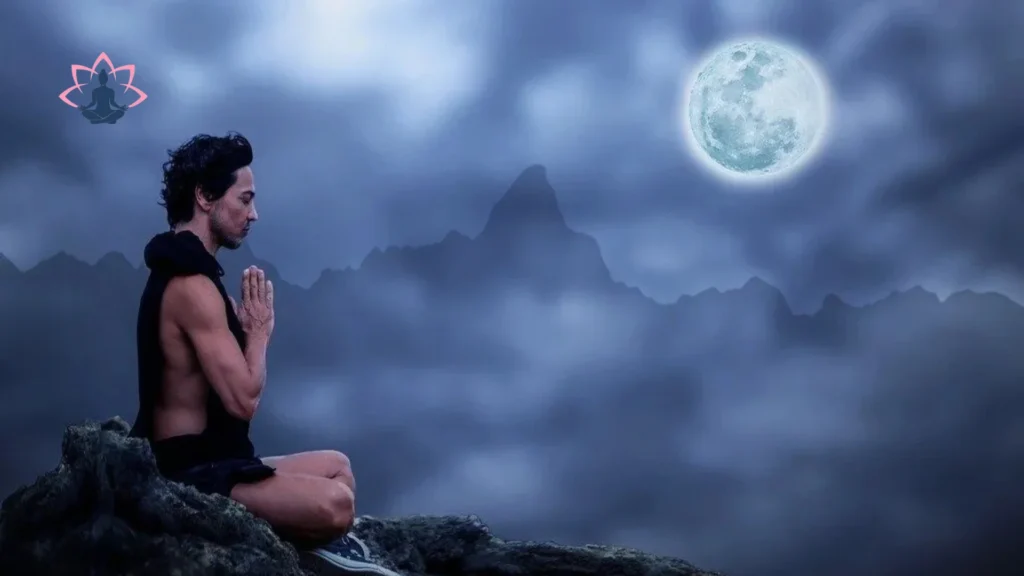
Chandra Namaskar for Evening Practice
Chandra Namaskar is perfect for evening practice since it harmonizes with the peaceful spirit of the night to promote mental and physical relaxation. Its soft, flowing motions mimic the calming effects of the moon, allowing tension from the day to be released and a transition into serenity. Deep breathing and the sequence’s deliberate pacing promote relaxation by triggering the parasympathetic nervous system, which primes the body for sleep. Chandra Namaskar’s repetitive movements and concentrated breathing facilitate a more seamless transition into deep sleep, therefore incorporating it into your evening routine can help manage sleep patterns.
Conclusion
A useful yoga technique for fostering relaxation, harmonizing the body and mind, and connecting with lunar energy is Chandra Namaskar. Whether practiced in the evening to unwind or as a way to honor the moon’s cycles, this salutation offers a harmonious and contemplative experience.
FAQ
What is Chandra Namaskar?
What is Chandra Namaskar?
Chandra Namaskar, or Moon Salutation, is a yoga sequence that honors the moon’s energy, promoting relaxation, introspection, and emotional balance46.
How does Chandra Namaskar differ from Surya Namaskar?
How does Chandra Namaskar differ from Surya Namaskar?
While both are salutation sequences, Chandra Namaskar focuses on lunar energy, promoting relaxation, while Surya Namaskar is solar-focused and energizing68.
What are the benefits of practicing Chandra Namaskar?
What are the benefits of practicing Chandra Namaskar?
Benefits include stress reduction, improved flexibility, emotional balance, better sleep, and enhanced spiritual connection4.
When is the best time to practice Chandra Namaskar?
When is the best time to practice Chandra Namaskar?
Chandra Namaskar is ideally practiced in the evening or at night to align with the moon’s tranquil energy, promoting relaxation and preparing for sleep28.
Are there any precautions to consider when practicing Chandra Namaskar?
Are there any precautions to consider when practicing Chandra Namaskar?
Beginners or individuals with back pain should modify poses as needed and avoid overexertion5.